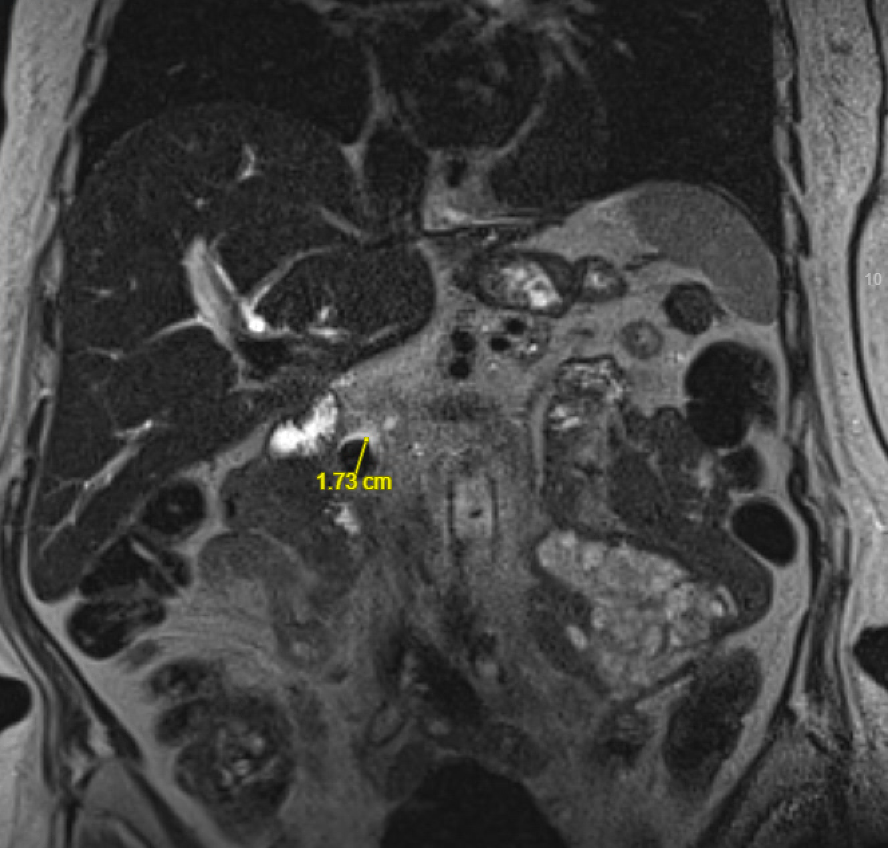Monday Poster Session
Category: Biliary/Pancreas
P2265 - Two Decades Later: The Biliary Tree Strikes Back
Monday, October 27, 2025
10:30 AM - 4:00 PM PDT
Location: Exhibit Hall

George Matar, MD
McGovern Medical School at UTHealth
Houston, TX
Presenting Author(s)
George Matar, MD1, Andrew T. Sullivan, MD2
1McGovern Medical School at UTHealth, Houston, TX; 2McGovern Medical School at UTHealth Houston, Houston, TX
Introduction: Cholecystectomy is the definitive treatment for symptomatic gallstone disease. While typically successful, some patients develop postcholecystectomy syndrome (PCS), marked by persistent or recurrent biliary symptoms. Retained or recurrent common bile duct (CBD) stones are a known cause of PCS, usually arising within a few years of surgery. However, CBD stone development decades later is rare, with limited data on its incidence. We present a case of choledocholithiasis causing cholangitis 20 years post-cholecystectomy, underscoring the importance of considering this diagnosis in patients with remote surgical histories presenting with biliary symptoms or abnormal liver chemistries.
Case Description/
Methods: A 68-year-old woman with a history of cholecystectomy 20 years prior presented with 3 days of fever and fatigue. She was febrile to 103.1°F with leukocytosis (WBC 13.46 x10³/µL). Liver enzymes were elevated: ALT 70 U/L, AST 126 U/L, alkaline phosphatase 1367 U/L, total bilirubin 2.8 mg/dL, direct bilirubin 2.1 mg/dL. Blood cultures grew ESBL-producing Escherichia coli confirming bacteremia. RUQ ultrasound showed a 1.0 cm dilated CBD. MRCP revealed a 1.7 cm stone in the distal CBD, with upstream intrahepatic and extrahepatic ductal dilation (up to 1.4 cm). The patient was diagnosed with acute cholangitis secondary to choledocholithiasis. Due to altered anatomy from a prior Roux-en-Y procedure, endoscopic ultrasound-directed transgastric ERCP was unsuccessful. After a multidisciplinary evaluation, she underwent inpatient biliary drain placement with plans for outpatient stone extraction.
Discussion: CBD stones are classified as secondary, originating from the gallbladder, or primary, arising de novo within the bile duct, typically >2 years post-cholecystectomy. Primary stones are infrequent in Western populations and rarely reported beyond a decade after surgery. The 20-year interval in this case strongly suggests a primary etiology, representing an exceptionally delayed presentation of PCS. Clinicians should maintain a high index of suspicion for choledocholithiasis in patients presenting with biliary symptoms or cholestatic liver enzymes, regardless of remote cholecystectomy history. Early diagnosis is critical, given the potential for significant morbidity associated with delayed primary CBD stones.

Figure: Large 1.7 cm stone in the distal common bile duct just proximal to the ampulla
Disclosures:
George Matar indicated no relevant financial relationships.
Andrew Sullivan indicated no relevant financial relationships.
George Matar, MD1, Andrew T. Sullivan, MD2. P2265 - Two Decades Later: The Biliary Tree Strikes Back, ACG 2025 Annual Scientific Meeting Abstracts. Phoenix, AZ: American College of Gastroenterology.
1McGovern Medical School at UTHealth, Houston, TX; 2McGovern Medical School at UTHealth Houston, Houston, TX
Introduction: Cholecystectomy is the definitive treatment for symptomatic gallstone disease. While typically successful, some patients develop postcholecystectomy syndrome (PCS), marked by persistent or recurrent biliary symptoms. Retained or recurrent common bile duct (CBD) stones are a known cause of PCS, usually arising within a few years of surgery. However, CBD stone development decades later is rare, with limited data on its incidence. We present a case of choledocholithiasis causing cholangitis 20 years post-cholecystectomy, underscoring the importance of considering this diagnosis in patients with remote surgical histories presenting with biliary symptoms or abnormal liver chemistries.
Case Description/
Methods: A 68-year-old woman with a history of cholecystectomy 20 years prior presented with 3 days of fever and fatigue. She was febrile to 103.1°F with leukocytosis (WBC 13.46 x10³/µL). Liver enzymes were elevated: ALT 70 U/L, AST 126 U/L, alkaline phosphatase 1367 U/L, total bilirubin 2.8 mg/dL, direct bilirubin 2.1 mg/dL. Blood cultures grew ESBL-producing Escherichia coli confirming bacteremia. RUQ ultrasound showed a 1.0 cm dilated CBD. MRCP revealed a 1.7 cm stone in the distal CBD, with upstream intrahepatic and extrahepatic ductal dilation (up to 1.4 cm). The patient was diagnosed with acute cholangitis secondary to choledocholithiasis. Due to altered anatomy from a prior Roux-en-Y procedure, endoscopic ultrasound-directed transgastric ERCP was unsuccessful. After a multidisciplinary evaluation, she underwent inpatient biliary drain placement with plans for outpatient stone extraction.
Discussion: CBD stones are classified as secondary, originating from the gallbladder, or primary, arising de novo within the bile duct, typically >2 years post-cholecystectomy. Primary stones are infrequent in Western populations and rarely reported beyond a decade after surgery. The 20-year interval in this case strongly suggests a primary etiology, representing an exceptionally delayed presentation of PCS. Clinicians should maintain a high index of suspicion for choledocholithiasis in patients presenting with biliary symptoms or cholestatic liver enzymes, regardless of remote cholecystectomy history. Early diagnosis is critical, given the potential for significant morbidity associated with delayed primary CBD stones.

Figure: Large 1.7 cm stone in the distal common bile duct just proximal to the ampulla
Disclosures:
George Matar indicated no relevant financial relationships.
Andrew Sullivan indicated no relevant financial relationships.
George Matar, MD1, Andrew T. Sullivan, MD2. P2265 - Two Decades Later: The Biliary Tree Strikes Back, ACG 2025 Annual Scientific Meeting Abstracts. Phoenix, AZ: American College of Gastroenterology.
